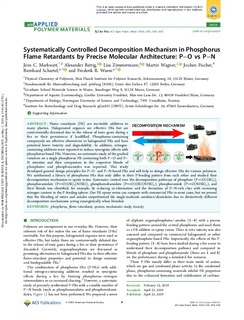| dc.contributor.author | Markwart, Jens | |
| dc.contributor.author | Battig, Alexander | |
| dc.contributor.author | Zimmermann, Lisa | |
| dc.contributor.author | Wagner, Martin | |
| dc.contributor.author | Fischer, Jochen | |
| dc.contributor.author | Schartel, Bernhard | |
| dc.contributor.author | Wurm, Frederik | |
| dc.date.accessioned | 2020-02-03T13:56:33Z | |
| dc.date.available | 2020-02-03T13:56:33Z | |
| dc.date.created | 2020-01-17T10:48:35Z | |
| dc.date.issued | 2019 | |
| dc.identifier.issn | 2574-0970 | |
| dc.identifier.uri | http://hdl.handle.net/11250/2639349 | |
| dc.description.abstract | Flame retardants (FR) are inevitable additives to many plastics. Halogenated organics are effective FRs but are controversially discussed due to the release of toxic gases during a fire or their persistence if landfilled. Phosphorus-containing compounds are effective alternatives to halogenated FRs and have potential lower toxicity and degradability. In addition, nitrogen-containing additives were reported to induce synergistic effects with phosphorus-based FRs. However, no systematic study of the gradual variation on a single phosphorus FR containing both P–O and P–N moieties and their comparison to the respective blends of phosphates and phosphoramides was reported. This study developed general design principles for P–O- and P–N-based FRs and will help to design effective FRs for various polymers. We synthesized a library of phosphorus FRs that only differ in their P-binding pattern from each other and studied their decomposition mechanism in epoxy resins. Systematic control over the decomposition pathways of phosphate (P═O(OR)3), phosphoramidate (P═O(OR)2(NHR)), phosphorodiamidate (P═O(OR)(NHR)2), phosphoramide (P═O(NHR)3), and their blends was identified, for example, by reducing cis-elimination and the formation of P–N-rich char with increasing nitrogen content in the P-binding sphere. Our FR epoxy resins can compete with commercial FRs in most cases, but we proved that the blending of esters and amides outperformed the single-molecule amidates/diamidates due to distinctively different decomposition mechanisms acting synergistically when blended. | nb_NO |
| dc.language.iso | eng | nb_NO |
| dc.publisher | American Chemical Society | nb_NO |
| dc.rights | Navngivelse 4.0 Internasjonal | * |
| dc.rights.uri | http://creativecommons.org/licenses/by/4.0/deed.no | * |
| dc.title | Systematically controlled decomposition mechanism in phosphorus flame retardants by precise molecular architecture | nb_NO |
| dc.type | Journal article | nb_NO |
| dc.type | Peer reviewed | nb_NO |
| dc.description.version | publishedVersion | nb_NO |
| dc.source.journal | ACS Applied Nano Materials | nb_NO |
| dc.identifier.doi | 10.1021/acsapm.9b00129 | |
| dc.identifier.cristin | 1775550 | |
| dc.description.localcode | This is an open access article published under a Creative Commons Attribution (CC-BY) License, which permits unrestricted use, distribution and reproduction in any medium, provided the author and source are cited. | nb_NO |
| cristin.unitcode | 194,66,10,0 | |
| cristin.unitname | Institutt for biologi | |
| cristin.ispublished | true | |
| cristin.qualitycode | 1 | |

